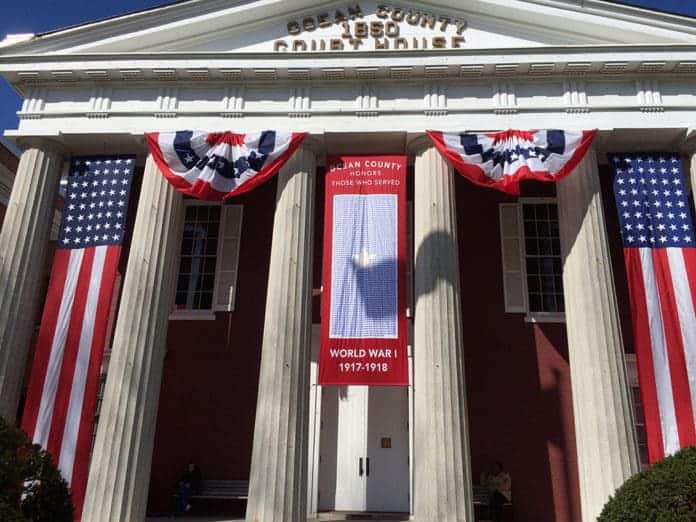
Though history played out on that international stage, here in New Jersey the anniversary is a time to unearth the local impact of WWI, and those efforts include some special events and exhibits.
WWI began in Europe on July 28, 1914 with the assassination of Austrian Archduke Franz Ferdinand by a Serb, and it lasted until November 11, 1918. At the beginning of the war, President Woodrow Wilson pledged neutrality for the United States, which most Americans favored, but after a series of incidents, including the May 7, 1915 sinking of a British ocean liner, the RMS Lusitania, which was en route from New York to Liverpool, England.
More than 1,100 passengers died, including some 120 Americans, which helped to turn public opinion against Germany. Nearly two years later on April 2, 1917, Wilson requested that Congress declare war on Germany, which Congress did on April 6. Wilson signed the war declaration on April 7.
The population of Ocean County back then was around 23,000, and according to the Ocean County Cultural and Heritage Commission, residents here took to the war effort “with patriotic zeal.”
In May 1917, Congress passed a bill for “selective draft,” a force that supplemented the regular Army and the National Guard, which numbered around 370,000. When Wilson created the selective service, an estimated 3 million were drafted and an estimated 2 million volunteered.
The men who were drafted – doughboys, as they were called during the 19 months American troops were involved in the war – were selected from able-bodied male citizens between the ages of 21 and 30 (unless they had dependent families and certain other specified classes) and would be liable to military service if drafted.
At the time America entered the war the US Army numbered 133,000 troops, but by the end of the war that number had grown to over 4 million.

The first selective service draft was in August 1917, and in Ocean County there was an initial quota of 169 conscripts, many of who gathered at the Toms River Courthouse steps on September 19 for a public send-off before their training started at the newly-created Camp Dix.
A few months later, in February 1918, 139 soldiers with scarlet fever were transferred to the newly-created General Hospital No. 9 at the luxurious Lakewood Hotel.
The hospital would treat some 5,500 soldiers during the year and a half, and had a staff of 773 doctors, nurses and other employees at its height.
Although there are no records in the county or state that tells how many Ocean County men served in World War 1, some 1,200 servicemen returned home to Ocean County after the Armistice was signed on November 11, 1918.
The servicemen were discharged to the local U.S. Army base at Camp Kendrick on the old Proving Grounds at Lakehurst.
The book, Ocean County: Four Centuries in the Making, says the Ocean County Board of Freeholders held a celebration at the county courthouse in Toms River for the returning veterans. That was held on the first anniversary of the signing of the Armistice on November 11, 1919.
The overflowing crowd began with members of the newly-formed American Legion Post 129 and the Toms River Fire Company marched down Washington Street.
A handmade flag was presented to the Post by Mrs. Charles Vanderveer in memory of her son, Toms River resident George P. Vanderveer, who was the first Ocean County soldier to die from his wounds in battle in 1918.
The American Legion Post is named after Vanderveer, and has several plaques memorializing him. He died at 20 years old at home, after suffering through a gas attack and subsequent shellshock. He returned home to convalesce.
After the war ended, the draft was abolished, flour was no longer rationed and restrictions on public works and private construction were lifted. Munitions factories slowed down and converted back to manufacturing supplies and materials.
According to an article in the Ocean County Observer, American Army officers were trained at Wanamaker Hall in Island Heights. In August 1919, John Wanamaker, then an 80-year old Philadelphia department store owner, had a sculptor create a monument marking the victory over the Germans at Verdun in France and had it put on the shore of Barnegat Bay, facing east.
Brick Township Historian Gene Donatiello forwarded a story from a book written by George Cook about a Brick resident who served during WW1.
“Percy Gant: the Man Behind the Decoy” tells the story about Gant, who was born in 1894 in the village of Osbornville, Brick Township.
“Percy, like most young men of Osbornville, took to trapping muskrats, duck hunting and fishing the upper Barnegat Bay area,” wrote Cook.
Gant married Melina Maxon in 1915, and two years later, in May of 1919, left to fight in WW1.
When he returned from the war, he purchased a home at 241 Drum Point Road and took up a career in carpentry. Percy also developed a local cranberry business owning and operating several bogs in the Osbornville area.
With his interest in hunting combined with his talents in woodworking, Gant was a natural to be a carver of duck and bird decoys, Cook wrote.
A Mallard decoy of Percy Gant’s now in the Shelbourne Museum, Vt., was selected in 1984 by the United States Postal Service to be placed on a four block of postage stamps depicting American Folk Art. Gant died on August 24, 1963.
The War to End All Wars came at a great cost to the US, where 53,000 died, 200,000 were wounded, and another 60,000 died from disease; more than 3,400 New Jersey men were killed in action or otherwise died during the war.
On April 6, the Ocean County Freeholders commemorated the 100th anniversary of The Great War at the courthouse to honor the 2,433 Ocean County men who served in the war. Of those, 75 were killed in action.
During the month of April, the Ocean County Library’s headquarters, 101 Washington St. in Toms River, is hosting the New Jersey WWI Roadshow Art Exhibit, an exhibit showcasing posters and artwork commemorating the 100th anniversary of WWI.
For more, read our report from the April 6th ceremony in Downtown Toms River.






